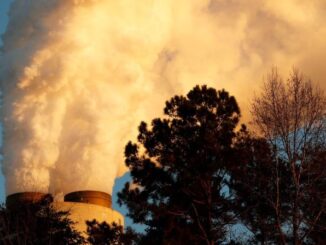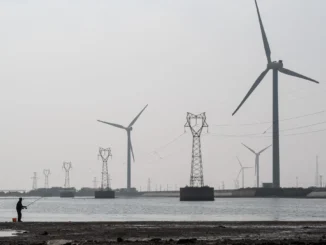
ENB Pub Note: This is from David Blackmon’s Substack, and he has yet again hit it out of the park. We highly recommend subscribing to David’s work.
When the EPA does take the sledgehammer to the Obama-era declaration that CO2 is a pollutant, we will see further bifurcation of the global financial markets. This split will be along the lines of the Net-Zero energy policy camp and those who choose financial prosperity.
Well, folks, it looks like the Trump administration is gearing up to take a sledgehammer to one of the most overreaching, unscientific regulatory edifices ever erected: the EPA’s 2009 “endangerment finding.” According to a report from The New York Times, the Environmental Protection Agency has drafted a plan to rescind this cornerstone of federal climate policy, which declared that greenhouse gases like carbon dioxide and methane pose a danger to human health and welfare.
If this move succeeds, it could unravel the federal government’s ability to regulate carbon dioxide emissions from cars, power plants, and industries—a prospect that has the climate alarmist crowd clutching their pearls. And frankly, it’s about time someone challenged this rank absurdity.
Let’s take a walk down green fantasy memory lane to 2009, when the Obama-era EPA, emboldened by the 2007 Supreme Court ruling in Massachusetts v. EPA, decided to anoint itself the arbiter of America’s energy future. The endangerment finding was born, asserting that CO2 – literally plant food, and the fundamental building block for all life on planet Earth – is a pollutant that “endangers public health.” The very concept is so absurd it defies description.
This wasn’t based on some groundbreaking scientific discovery but rather on a political agenda dressed up in green rhetoric. The finding became the legal foundation for a slew of regulations, from tailpipe emissions standards to power plant rules, all designed to choke the fossil fuel industry and push the U.S. toward a so-called “clean energy” utopia that exists only in the fever dreams of climate activists.
Now, the Trump EPA, led by Administrator Lee Zeldin, appears poised to dismantle this house of cards. The NYTimes says the draft proposal, sent to the White House for review, argues that the EPA overstepped its authority under the Clean Air Act by issuing such a sweeping determination.
Instead of engaging in an attempt to deny the pseudo-science of climate change, the plan focuses on a legal argument: the EPA’s administrator lacks the power to make broad proclamations about greenhouse gases without specific congressional authorization. This is a direct jab at the 2007 Supreme Court decision, which, let’s be honest, was a judicial overreach that gave unelected bureaucrats a blank check to regulate the economy. Let’s also remember that that decision came at a time when the Chevron Deference, which the Court did away with a year ago, was still in effect.
The climate alarm crowd is already screaming bloody murder. Vickie Patton of the Environmental Defense Fund called the evidence for climate change “overwhelming and incontrovertible,” as if repeating a mantra makes it unassailable. Joseph Goffman, a former EPA official under Biden, warned that the proposal will face legal challenges, citing the Massachusetts v. EPA ruling. But that seems a weak retort given the likelihood of a loss at the Supreme Court now that the Chevron Deference no longer exists.
The reality here is that the science isn’t as settled as they’d like you to believe, and the legal foundation is shakier than a Jenga tower in a windstorm. The Clean Air Act was never designed to regulate CO2, a point even the late Rep. John Dingell, a co-author of the Act, made clear. Congress has repeatedly rejected climate legislation, yet the EPA has been allowed to legislate through regulation—a textbook case of bureaucratic overreach.
What’s more, the endangerment finding has been a blunt instrument, used to justify policies that raise energy costs, kill jobs, and limit consumer choice. Take the Biden administration’s tailpipe emissions rules, which the Trump EPA also plans to scrap. These regulations pushed automakers to prioritize electric vehicles, despite their high costs, limited range, and dependence on Chinese-controlled supply chains.
The transportation sector, the largest source of U.S. greenhouse gas emissions, has been a prime target, but the EPA’s argument that these rules protect human health ignores the economic harm they inflict—higher prices, fewer choices, and a weaker energy grid. The Trump team’s counterargument is spot-on: forcing Americans into EVs isn’t saving lives; it’s squeezing wallets and stifling innovation.
Of course, the green lobby will drag this fight into the courts, and they’ve got a point that overturning the finding won’t be easy. The EPA must navigate a minefield of procedural requirements under the Administrative Procedure Act, and the alarmists will try to overwhelm the courts with claims that climate change has only grown since 2009, claiming every extreme weather event somehow proves their case.
But the Trump administration isn’t denying climate change outright; it’s questioning whether the EPA has the legal authority to act as America’s climate czar. This is a fight worth having, because if the agency can regulate CO2 without clear congressional approval, what’s stopping it from declaring water vapor a pollutant next?
The bigger picture here is the absurdity of the energy transition itself. The endangerment finding has been a cudgel to force a shift away from reliable, affordable fossil fuels toward a fantasy of windmills and solar panels that can’t power a modern economy. The U.S. is the second-largest emitter of greenhouse gases globally, but even if we zeroed out emissions tomorrow, global temperatures would barely budge without similar action from China and India.
Meanwhile, Americans bear the brunt of higher energy costs and a less reliable grid. Rescinding the endangerment finding could free up the economy to innovate without the EPA’s heavy hand, letting market forces—not bureaucrats—drive energy solutions.
This move is a bold step toward dismantling the regulatory state’s stranglehold on American energy. It won’t be quick or easy, and the climate zealots will fight tooth and nail. But if the Trump administration can pull it off, it’ll be a victory for common sense over green dogma. Stay tuned—this fight’s just getting started.
That is all.





